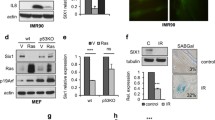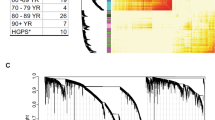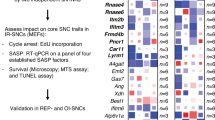Abstract
The changes in gene expression during senescence are very interesting. Early population doubling cDNA-1 (EPC-1, also known as pigment epithelial derived factor, PEDF) is one of the genes whose expression decreases dramatically during cellular aging. We examined whether or not EPC-1/PEDF promoter activity was affected by the cellular ageing using human diploid lung fibroblast cells in culture. Here we showed the promoter/enhancer region of EPC-1/PEDF existed at more than 1760 bp upstream from the transcriptional initiation site of the gene, and was regulated by both aging and cell cycle. These findings suggest that the expression of the EPC-1/PEDF gene is, at least in part, regulated transcriptionally in the cells. The analysis of the promoter region of the EPC-1/PEDF gene in this paper suggests the age- and cell cycle-dependent expression of specific transcriptional factor(s).
Similar content being viewed by others
References
Hayflick L, Moorhead PS: The serial cultivation of human diploid cell stains. Exp Cell Res 25: 585–621, 1961
Hayflick L: The limit in vitro life-time of human diploid cell strain. Exp Cell Res 37: 614–636, 1965
Ciccarelli C, Philipson L, Sorrentino V: Regulation of expression of growth arrest-specific gene in mouse fibroblast. Mol Cell Biol 10: 1525–1529, 1990
Cristofalo VJ, Volker C, Francis MKF, Tresini M: Age dependent modification of gene expression in human fibroblast. Crit Rev Eukaryot Gene Expr 8: 43–80, 1998
Pignolo RJ, Cristofalo VJ, Rotenberg MO: Senescent WI-38 cells fail to express EPC-1, a gene induced in young cells upon entry into the G0 state. J Biol Chem 268: 8949–8957, 1993
Pignolo RJ, Rotenberg MO, Cristofalo VJ: Analysis of EPC-1 growth state-dependent expression, specificity, and conservation of related sequences. J Cell Physiol 162: 110–118, 1995
Pignolo RJ, Rotenberg MO, Cristofalo VJ: Alterations in contact and density-dependent arrest state in senescent WI-38 cells. In vitro Cell Dev Biol Anim 30A: 471–476, 1994
Taniwaki T, Becerra SP, Chader GJ, Schwartz JP: Pigment epithelium-derived factor is a survival factor for cerebellar granule cells in culture. J Neurochem 64: 2509–2517, 1995
Taniwaki T, Hirashima N, Becerra SP, Chader GJ, Etcheberrigaray R, Schwartz JP: Pigment epithelium-derived factor protects cultured cerebellar granule cells against glutamate-induced neurotoxicity. J Neurochem 68: 26–32, 1997
Sugita Y, Becerra SP, Chader GJ, Schwartz JP: Pigment epithelium-derived factor (PEDF) has direct effects on the metabolism and proliferation of microglia and indirect effects on astrocytes. J Neurosci Res 49: 710–718, 1997
Araki T, Taniwaki T, Becerra SP, Chader GJ, Schwartz JP: Pigment epithelium-derived factor (PEDF) differentially protects immature but not mature cerebellar gramule cells against apoptotic cell death. J Neurosci Res 53: 7–15, 1998
Bilak MM, Corse AM, Bilak SR, Lehar M, J. Tombran-Tink, Kuncl RW: Pigment epithelium-derived factor (PEDF) protects motor neurons from chronic glutamate-mediated neurodegeneration. J Neuropathol Exp Neurol 58: 719–728, 1999
Cao W, Tombran-Tink J, Chen W, Mrazek D, Elias R, McGinnis JF: Pigment epithelium-derived factor protects cultured retinal neurons against hydrogen peroxide-induced cell death. J Neurosci Res 57: 789–800, 1999
Cayouette M, Smith SB, Becerra SP, Gravel C: Pigment epithelium-derived factor delays the death of photoreceptors from light damage by mouse models of inherited retinal degenerations. Neurobiol Dis 6: 523–532, 1999
Dawson DW, Volpert OV, Gillis Crawford SE P, Xu H, Benedict W, Bouck NP: Pigment epithelium-derived factor: a potent inhibitor of angiogenesis. Science 285: 245–248, 1999
DeCoster MA, Schabelman E, Tombran-Tink J, Bazan NG: Neuroprotection by pigment epithelium-derived factor against glutamate toxicity in developing primary hippocampal neurons. J Neurosci Res 56: 604–610, 1999
Houenou LJ, D'Costa AP, Li L, Turgeon VL, Enyadike C, Alberdi E, Bcerra SP: Pigment epithelium-derived factor promotes the survival and differentiation of developing spinal motor neurons. J Comp Neurol 412: 506–514, 1999
Cohen J, Sugita Y, Chader GJ, Schwartz JP: Recombinant formsof the neurotrophic factor pigment epithelium-derived factor activate cellular metabolism and inhibit proliferation of the RAW macrophage cell line. Neuroimmunomodulation 7: 51–58, 2000
Crawford SE, Stellmach V, Ranalli M, Huang X, Huang L, Velpert O, De Vries GH, Abramson LP, Bouck N: Pigment epithelium-derived factor (PEDF) in neuroblastoma: A multifunctional mediator of Schwann cell antitumor activity. J Cell Sci 114: 4421–4428, 2001
Mori K, Duh E, Gehlbach P, Ando A, Takahashi K, Pearlman J, Mori K, Yang HS, Zack DJ, D. Ettyreddy, Brough DE, Wei LL, Campochiaro PA: Pigment epithelium-derived factor inhibits retinal and choroidal neovascularization. J Cell Physiol 188: 253–263, 2001
Nomura T, Yabe T, Mochizuki H, Reiser J, Becerra SP, Schwartz JP: Survival effects of pigment epithelium-derived factor expressed by a lentiviral vector in rat cerebellar granule cells. Dev Neurosci 23: 145–152, 2001
Ogata N, Wang L, Jo N, Tombran-Tink J, Takahashi K, Mrazek D, Matsumura M: Pigment epithelium-derived factor as a neuroprotective agent against ischemic retinal injury. Curr Eye Res 22: 245–252, 2001
Stellmach V, Crawford SE, Zhou W, Bouck N: Prevention of ischemia-induced retinopathy by the natural ocular antiangiogenic agent pigment epithelium-derived factor. Proc Natl Acad USA 98: 2593–2597, 2001
Matsuo M, Kaji K, Utakoji T, Hosoda K: Ploidy of human embryonic fibroblasts during in vitro aging. J Gerontol 37: 33–37, 1982
Yamamoto M, Mitsui Y, Ooka H, Yamamoto K: Appearance of the terminal senescent cell population in human diploid fibroblast analyzed by flow cytometry. Mech Ageing Dev 51: 195–214, 1990
Laemmli UK, Beguin F, Gujer-Kellenberger G: A factor preventing the major head protein of bacteriophage T4 from random aggregation. J Mol Biol 47: 69–85, 1970
Francis MK, Apple S, Meyer C, Balin SJ, Balin AK, Cristofalo VJ: Loss of EPC-1/PEDF expression during skin aging in vivo. J Invest Dermatol 122: 1096–1105, 2004
Coljee VW, Rotenberg MO, Tresini M, Francis MK, Cristofalo VJ, Sell C: Regulation of EPC-1/PEDF in normal human fibroblasts is posttranscriptional. J Cell Biochem 79: 442–452, 2000
Yoon IK, Kim HK, Kim YK, Song IH, Kim W, Kim S, Baek SH, Kim JH, Kim JR: Exploration of replicative senescence-associated genes in human dermal fibroblasts by cDNA microarray technology. Exp Gerontol 39: 1369–1378, 2004
Shelton DN, Chang E, Whittier PS, Funk WD: Microarray analysis of replicative senescence. Curr Biol 9: 939–945, 1999
Ly DH, Lerner DJ, Schltz PG: Mitotic misregulatuon and human aging. Science 287: 2486–2492, 2000
Zhang H, Pan KH, Cohen SN: Senescence-specific gene expression fingerprints reveal cell-type-dependent physical clustering of up-regulated chromosomal loci. Proc Natl Acad Sci USA 100: 3251–3256, 2003
Choi BH, Kim JS: Age-related decline in expression of calnexin. Exp Mol Med 36: 499–503, 2004
Geigl JB, Langer S, Barwisch S, Pfleghaar K, Lederer G, Speicher MR: Analysis of gene expression patterns and chromosomal changes associated with aging. Cancer Res 64: 8550–8557, 2004
Cho KA, Ryu SJ, Ahn JS, Kim KT, Park SC: Senescent phenotype can be reversed by reduction of caveolin status. J Biol Chem 278: 27789–27795, 2003
Kayo T, Allison DB, Weindruch R, Prolla TA: Influences of aging and caloric restriction on the transcriptional profile of skeletal muscle from rhesus monkeys. Proc Natl Acad Sci USA 98: 5093–5098, 2001
Lee CK, Klopp RG, Weindruch R, Prolla TA: Gene expression profile of aging and its retardation by caloric restriction. Science 285: 1390–1393, 1999
Lee CK, Weindruch R, Prolla TA: Gene-expression profile of the ageing brain in mice. Nat Genet 25: 294–297, 2000
Tollet-Egnell P, Flores-Morales A, Stahlberg N, Malek RL, Lee N, Norstedt G: Gene expression profile of the aging process in rat liver: Normalizing effects of growth hormone replacement. Mol Endocrinol 15: 308–318, 2001
Sasaki Y, Naishiro Y, Oshima Y, Imai K, Nakamura Y, Tokino T: Identification of pigment epitherium-derived factor as a direct target of p53 family member genes. Oncogene: 1–6, 2005
Tombran-Tink J, Mazuruk K, Rodriguez IR, Chung D, Linker T, Englander E, Chader GJ: Organization, evolutionary conservation, expression and unusual Alu density of human gene for pigment epitherium-derived factor, a unique neurotrophic serpin. Mol Vis 2: 1996
Norris J, Fan D, Alemans C, Marks JR, Futreal PA, Wiseman RW, Iglehart JD, Deiningers PL, McDonnell DP: Identification of a new subclass of Alu DNA repeats which can function as estrogen receptor-dependent transcriptional enhancers. J Biol Chem 270: 22777–22782, 1995
Vansant G, Reynolds WF, The consensus sequence of a major Alu subfamily contains a functional retinoic acid response element. Proc Natl Acad Sci USA 92: 8229–8233, 1995
Li LC, Yeh CC, Nojima D, Dahiya R: Cloning and characterization of human estrogen receptor B promoter. Biochem. Biophys Res Commun 275: 682–689, 2000
Oei SL, Babich VS, Kazakov VI, Usmanova NM, Kropov AV, Tomilin NV: Clusters of regulatory signals for RNA polymerase 2 transcription associated with Alu family repeats and CpG islands in human promoters. Genomics 83: 873–882, 2004
Moon SK, Cha BY, Lee YC, Nam KS, Runge MS, Patterson C, Kim CH: Age-related changes in matrix metalloproteinase-9 regulation in cultured mouse aortic smooth muscle cells. Exp Gerontol 39: 123–131, 2004
Wang W, Yang X, Cristofalo VJ, Holbrook NJ, Gorospe M: Loss of HuR is linked to reduced expression of proliferative genes during replicative senescence. Mol Cell Biol 21: 5889–5898, 2001
Author information
Authors and Affiliations
Corresponding author
Rights and permissions
About this article
Cite this article
Kojima, T., Nakahama, Ki., Yamamoto, K. et al. Age- and cell cycle-dependent changes in EPC-1/PEDF promoter activity in human diploid fibroblast-like (HDF) cells. Mol Cell Biochem 293, 63–69 (2006). https://doi.org/10.1007/s11010-006-2680-0
Received:
Accepted:
Published:
Issue Date:
DOI: https://doi.org/10.1007/s11010-006-2680-0




